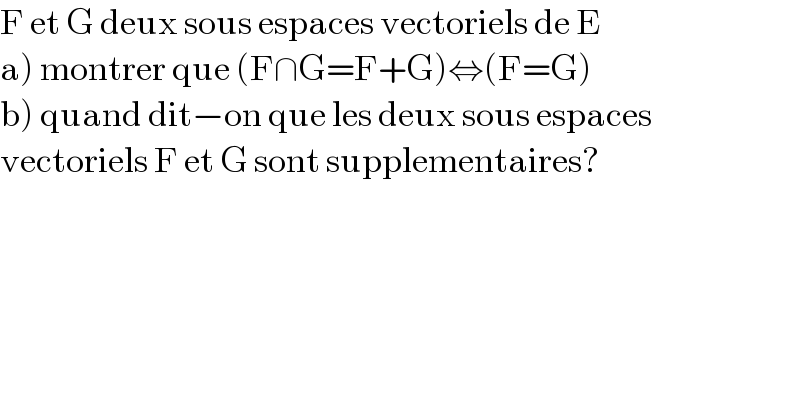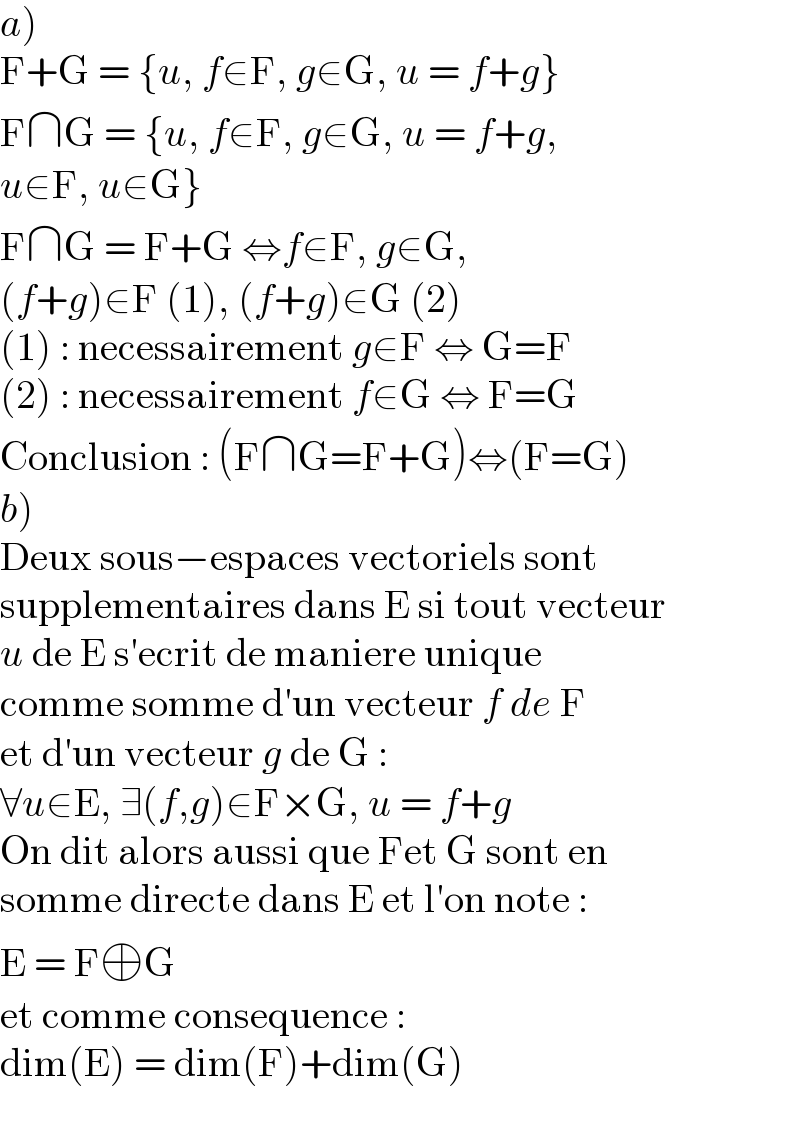
Question Number 146004 by puissant last updated on 10/Jul/21

$$\mathrm{F}\:\mathrm{et}\:\mathrm{G}\:\mathrm{deux}\:\mathrm{sous}\:\mathrm{espaces}\:\mathrm{vectoriels}\:\mathrm{de}\:\mathrm{E} \\ $$$$\left.\mathrm{a}\right)\:\mathrm{montrer}\:\mathrm{que}\:\left(\mathrm{F}\cap\mathrm{G}=\mathrm{F}+\mathrm{G}\right)\Leftrightarrow\left(\mathrm{F}=\mathrm{G}\right) \\ $$$$\left.\mathrm{b}\right)\:\mathrm{quand}\:\mathrm{dit}−\mathrm{on}\:\mathrm{que}\:\mathrm{les}\:\mathrm{deux}\:\mathrm{sous}\:\mathrm{espaces}\: \\ $$$$\mathrm{vectoriels}\:\mathrm{F}\:\mathrm{et}\:\mathrm{G}\:\mathrm{sont}\:\mathrm{supplementaires}? \\ $$
Answered by Olaf_Thorendsen last updated on 10/Jul/21

$$\left.{a}\right) \\ $$$$\mathrm{F}+\mathrm{G}\:=\:\left\{{u},\:{f}\in\mathrm{F},\:{g}\in\mathrm{G},\:{u}\:=\:{f}+{g}\right\} \\ $$$$\mathrm{F}\cap\mathrm{G}\:=\:\left\{{u},\:{f}\in\mathrm{F},\:{g}\in\mathrm{G},\:{u}\:=\:{f}+{g},\right. \\ $$$$\left.{u}\in\mathrm{F},\:{u}\in\mathrm{G}\right\} \\ $$$$\mathrm{F}\cap\mathrm{G}\:=\:\mathrm{F}+\mathrm{G}\:\Leftrightarrow{f}\in\mathrm{F},\:{g}\in\mathrm{G}, \\ $$$$\left({f}+{g}\right)\in\mathrm{F}\:\left(\mathrm{1}\right),\:\left({f}+{g}\right)\in\mathrm{G}\:\left(\mathrm{2}\right) \\ $$$$\left(\mathrm{1}\right)\::\:\mathrm{necessairement}\:{g}\in\mathrm{F}\:\Leftrightarrow\:\mathrm{G}=\mathrm{F} \\ $$$$\left(\mathrm{2}\right)\::\:\mathrm{necessairement}\:{f}\in\mathrm{G}\:\Leftrightarrow\:\mathrm{F}=\mathrm{G} \\ $$$$\mathrm{Conclusion}\::\:\left(\mathrm{F}\cap\mathrm{G}=\mathrm{F}+\mathrm{G}\right)\Leftrightarrow\left(\mathrm{F}=\mathrm{G}\right) \\ $$$$\left.{b}\right) \\ $$$$\mathrm{Deux}\:\mathrm{sous}−\mathrm{espaces}\:\mathrm{vectoriels}\:\mathrm{sont} \\ $$$$\mathrm{supplementaires}\:\mathrm{dans}\:\mathrm{E}\:\mathrm{si}\:\mathrm{tout}\:\mathrm{vecteur}\: \\ $$$${u}\:\mathrm{de}\:\mathrm{E}\:\mathrm{s}'\mathrm{ecrit}\:\mathrm{de}\:\mathrm{maniere}\:\mathrm{unique} \\ $$$$\mathrm{comme}\:\mathrm{somme}\:\mathrm{d}'\mathrm{un}\:\mathrm{vecteur}\:{f}\:{de}\:\mathrm{F} \\ $$$$\mathrm{et}\:\mathrm{d}'\mathrm{un}\:\mathrm{vecteur}\:{g}\:\mathrm{de}\:\mathrm{G}\:: \\ $$$$\forall{u}\in\mathrm{E},\:\exists\left({f},{g}\right)\in\mathrm{F}×\mathrm{G},\:{u}\:=\:{f}+{g} \\ $$$$\mathrm{On}\:\mathrm{dit}\:\mathrm{alors}\:\mathrm{aussi}\:\mathrm{que}\:\mathrm{Fet}\:\mathrm{G}\:\mathrm{sont}\:\mathrm{en} \\ $$$$\mathrm{somme}\:\mathrm{directe}\:\mathrm{dans}\:\mathrm{E}\:\mathrm{et}\:\mathrm{l}'\mathrm{on}\:\mathrm{note}\:: \\ $$$$\mathrm{E}\:=\:\mathrm{F}\oplus\mathrm{G} \\ $$$$\mathrm{et}\:\mathrm{comme}\:\mathrm{consequence}\:: \\ $$$$\mathrm{dim}\left(\mathrm{E}\right)\:=\:\mathrm{dim}\left(\mathrm{F}\right)+\mathrm{dim}\left(\mathrm{G}\right) \\ $$
